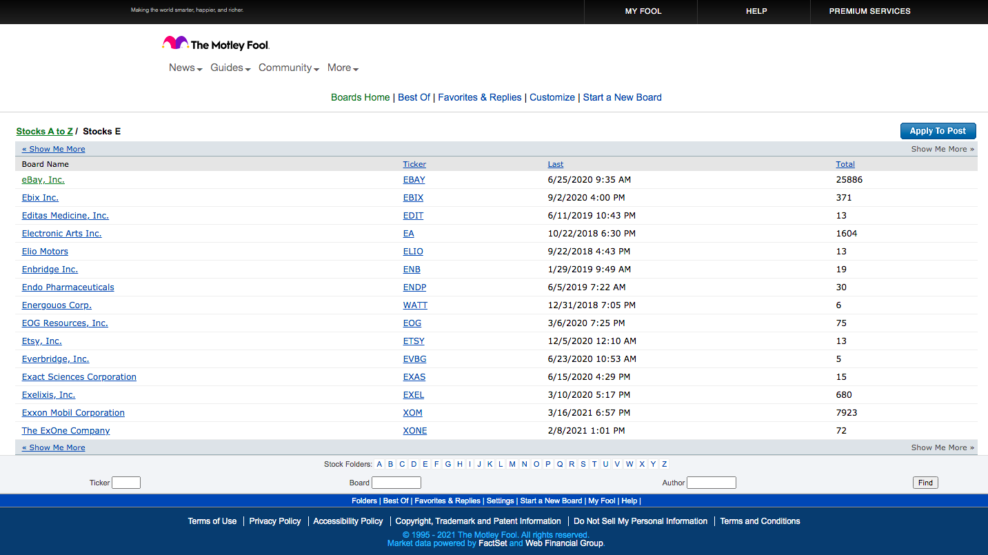
CentSai prides itself on writing independent reviews. Check out our rubric to see the objective standards we use.
Highest Possible Total Score:
If you’re new to investing, like I am, you may need some help to get started. When you’re first looking at the long lists of available stocks, it’s easy to feel intimidated. Investors need to have some confidence in their choices, and that can be difficult for beginners to develop — not to mention the fact that we need to know which brands to trust, or at least consider.
To make matters worse, it’s tough to even know where to look. With thousands of different platforms, apps, podcasts, and books, how are you supposed to figure out which stocks are the right choice for you? How are you going to know when to jump on an investment?
Thankfully, there are resources like the Motley Fool, which has been around for more than 20 years. The platform’s name is an homage to the Shakespearean court jester “who could speak the truth to the king or the queen without having his or her head lopped off.”
Who doesn’t want a service that isn’t afraid to question conventional wisdom, especially where investing one’s hard-earned money is concerned?
The site walks you through investing basics — if you ever wondered what the difference is between a blue chip or dividend stock, or what sectors you can consider investing in, The Fool tells it like it is.
Though it’s primarily a paid investing advice service, the Motley Fool also offers free educational resources to help you get started, and more than 1 million users receive the Stock Advisor subscription’s newsletters and recommendations.
 Ease of Use Score:2
Ease of Use Score:2
Navigating the Motley Fool’s main website can be difficult at times.
Between the cluttered home screen, the podcasts, the recommendations, and the array of sister sites — like the Ascent, a rating and review service, and Million Acres, a real estate investing advisor — the landing page appears to be a bit of a mess. Just deciding where to start was tough, but I took a few hours to click through the site, explore the forums, and peruse each of the articles.
After a while, I understood the platform layout and gained confidence in navigating the robust features, but a UX overhaul might help the Motley Fool reach millennial or Gen Z crowds who are used to a simpler and slicker user experience.

Once you get the lay of the land, there is a lot of information to glean from the site. At the top of the home page, the Motley Fool offers articles in four main categories: investing basics, stock market, retirement, and personal finance.
There are about 15 articles in each category on the home page, grouped into subtopics, that can help you build a basic understanding of financial literacy prior to investing.
There are also additional articles that can be found on the lower left side of the home screen, which describe why certain stocks drop, which bargain stocks are trading each day, and whether or not specific investments are good choices.
As a beginner, getting free analysis of individual stocks, plus explanations for why they rise and fall, is essential for understanding investing before I make the decision to buy stocks.
The site offers five free podcasts, each dedicated to providing listeners with information about the financial industry and markets.
 Podcasts include “Motley Fool Money,” led by a panel of investment analysts, which covers weekly current events in the financial industry and provides interviews with industry experts.
Podcasts include “Motley Fool Money,” led by a panel of investment analysts, which covers weekly current events in the financial industry and provides interviews with industry experts.
“Marketfoolery” is a daily podcast that looks at stocks and the day’s top business and investing stories.
“Industry Focus” discusses popular stocks relating to healthcare, technology, energy, and consumer goods. I found this one the most useful, as it allowed deep-cut insight into entire sectors, which is essential for a novice investor with little knowledge.
“Motley Fool Answers” allows personal finance expert Robert Brokamp to break down the essentials of spending, saving, and planning.
Finally, “Rule Breaker Investing” gives Motley Fool co-founder David Gardner the chance to share some of his insights on publicly traded companies. The discussions include advice about managing peak hours during remote working periods, the importance of diversification, and added analysis of specific stocks.
These podcasts can be found on the home page at the bottom of the screen, or they can be found in the “About Us” category.
The Motley Fool also hosts free discussion boards dedicated to topics from personal finance to health and fitness to relationship advice. A section of the forums is dedicated to major stocks, each listed in alphabetical order. If you have questions about a particular stock, this could be a great place to go.
On these discussion boards, individuals discuss their opinions of each stock, typically in greater — and better researched — detail than on other forums like Reddit.
For example, during the recent turmoil over the GameStop (GME) volatility, members of the Motley Fool forum were discussing the potential of a pump-and-dump scheme, while other forums jumped on the opportunity to participate in a short squeeze.
This essentially meant that Motley Fool users accurately predicted that the GME price would quickly collapse, rather than achieving the $1,000 per share goal that many Reddit forum users lusted after.
Personally, these forums were actually the feature I liked the most. I always love the chance to share and view opinions about the content I’m consuming. One of the recent discussions on the topic of a potential shortage of low-wage workers fascinated me enough to get me to dive into research for hours.
It’s a great way to reinforce the topics I’m learning about as well as a way to create a sense of community among the site’s users. That, alone, encourages you to keep coming back.

Notably, the Motley Fool currently has no functional app, meaning that users on their phones or tablets are instead directed to use the mobile version of the website. Though this was not an issue for me, as a remote worker who’s always near my laptop, this could be a hassle for those who need to be more mobile than I do.
 Bang for Your Buck Score:4
Bang for Your Buck Score:4
Many of the site’s recommendations and articles are free, including its articles, podcasts, videos, and more. The articles, specifically, help describe which stocks are best ignored, which top stocks to invest in, and why the market performs the way it does.
The paid subscriptions, on the other hand, afford users access to “official” stock recommendations, recommended investment strategies, analysis of specific stocks, and more insight into the opinions of various Motley Fool analysts.
The Stock Advisor subscription to the Motley Fool costs $99 for the first year, then $199 for each year after. Subscribers get two new hand-selected stock recommendations each month. In addition, on the first four Thursdays of each month, subscribers receive recommendations of 10 stocks that the Motley Fool analyst team expects to beat the market.
The company claims that, “The average stock pick inside Stock Advisor is up 563 percent vs. just 131 percent for the S&P.” When CentSai reached out for further information about this claim, the Motley Fool provided data to support their assertions. Returns were certainly helped by early Amazon and Netflix investments.
There are several other annual subscription options available, ranging from $200 to a whopping $13,999, each offering a wide array of services from model portfolios to full access to all of the Motley Fool’s resources — most notably, a list of companies expected to grow tenfold over the next few years.
But, as a beginner, it’s pretty unlikely that you’re going to need — or be able to afford — a $13,999 service. CentSai contacted Motley Fool in order to learn how many people use this service, and were told that the company was unable to share exact figures at the time.
As a note, the aforementioned top-tier subscription offers access to all of the site’s stock-picking “idea” services, and real money portfolios. You’re probably not going to want to spend nearly $14K per year when you may not even be completely sure how the stock market works.
Given that the paid subscriptions offer stock recommendations with a history of beating the market, they can be considered a great value for the price.
The free version of the website, however, is an excellent resource for financial literacy education, offering guides that really do start to introduce you to the world of investing, so that you can be ready for any long-term savings goals.
You don’t need to pay a dime to learn more about why some stocks fail, why others succeed, and why people in the forums are getting excited about one prospect or another.
 Customer Service Score:2
Customer Service Score:2

In order to contact the Motley Fool, you can either reach the company through an email form that can be found here or via this number: 877-629-2589. It is important to note, however, that you will not receive a response to the email form, unless you have already signed on for an annual subscription.
If you choose to call the Motley Fool, be aware that (according to the site) wait times are higher than normal due to COVID-19. While you hold, the service plays a recent episode of the “Rule Breaker Investing” podcast. When I called the service, it took me six minutes to reach a representative.
 Reputation
Reputation


The Motley Fool has earned a “B” rating from the Better Business Bureau (BBB), while carrying a 4.03/5 user rating, and has earned a total of 73 complaints over the past year. It should be noted that it has not been given BBB accreditation. Since the Motley Fool does not have an app, we were not able to collect reviews from the App Store or Google Play.
 The Bottom Line
The Bottom Line

The Motley Fool is a helpful resource that provides genuine insight into some otherwise difficult-to-comprehend facts about investing. It may not be the easiest source to navigate, but after spending some time on the site, users can adapt.
If users choose to seek out premium subscriptions, having the latest stock pick selection can be a huge help for investors who may not have the time to scour the market. It’s a site designed to get beginning investors on par with experienced ones, and that’s not an easy balance to maintain, but Motley Fool does it well.
For those interested in learning about long-term investment strategies for retirement or other far-off goals, the Motley Fool could be an excellent choice.










